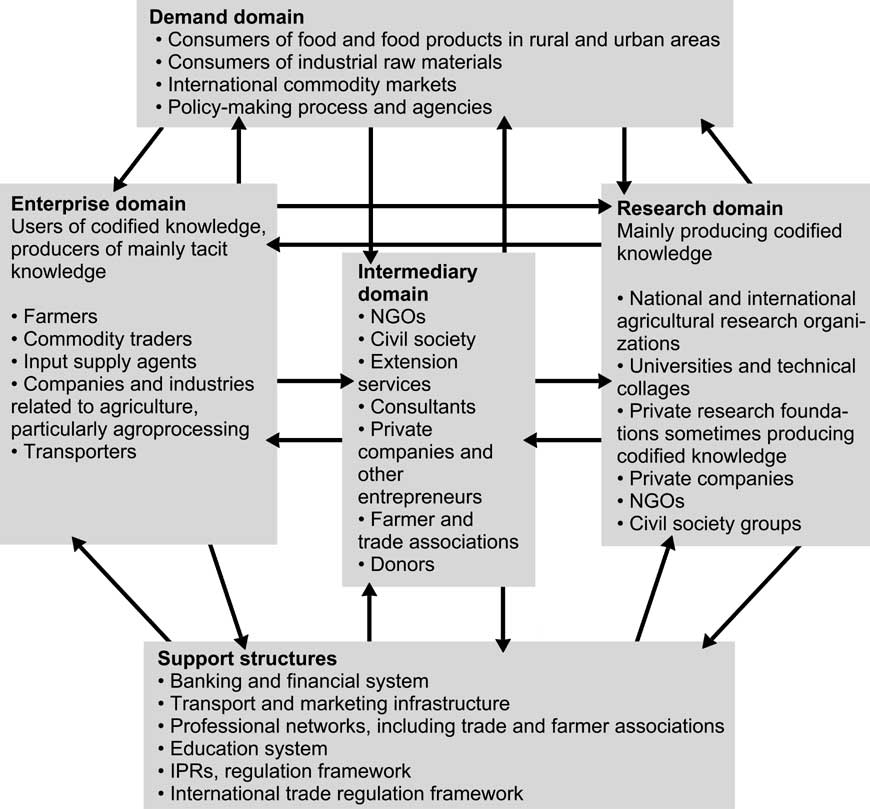
| Previous | Return to table of contents | Search Reports | Next |
| « Back to weltagrarbericht.de | ||
Historical Analysis of the Effectiveness of AKST Systems in Promoting Innovation | 75
|
gained in working with civil society on technological risk assessments and sustainability appraisals, sometimes involving large numbers of citizens (Pimbert and Wakeford, 2002; IIED, 2006; Pimbert et al., 2006). 2.2 Key Actors, Institutional Arrangements and Drivers Actors and institutions have power to set policy agendas and influence how research and development investments are made. All knowledge actors develop processes for generating AKST and innovation that evolve within their own IAs and culture of understanding. These processes can generate stress when key actors are excluded or marginalized by new or old arrangements (Table 2-3). The main actors considered here are in the vast majority farmers and farm laborers, many of whom are poor, with limited access to external resources and formal education, but rich in traditional and local knowledge and increasingly organized and adept at sharing knowledge and innovating. Additional domestic actors affecting the development and innovation of AKST include local, provincial and national governments, and the agencies, departments and ministries devoted to agriculture, environment, education, health, trade, finance, etc. Still other actors with direct impacts on AKST include regional consortia and international institutions, FAO, the Global Integrated Pest Management (IPM) Facility, the World Bank, CGIAR, private foundations, and others. Each organization develops and brings its own sets of priorities, perspectives and agendas to the business of |
AKST. Private sector actors who have played increasingly important roles are commercial and corporate players and civil society organizations (CSOs), including farmer and consumer organizations, foundations and those working for nonhuman species and the environment, as well as a range of development and relief NGOs. The currently dominant AKST systems are the product of a long history of attempts by diverse combinations of these actors, under numerous institutional arrangements (IAs), to meet the needs and challenges of agriculture in different contexts, as well as the actors' own individual or institutional needs. Their histories are made up of successes, but also failures and frustrations, often leading to new attempts at meeting both local and global challenges. In many instances, crises have led to the emergence of new actors and the reshuffling of roles and relationships. Institutional arrangements formally or informally coordinate the work of knowledge producers and engage them in distinctive knowledge processes, thus favoring the emergence of different kinds of innovation. Some become long-standing permanent arrangements; others are ad hoc initiatives or of more recent origin. 2.2.1 Farmer and community-based arrangements The emergence of major producer organizations representing their members' interests and rights at district, national, regional and international levels may be seen as an increasingly strong driver of change over the last decades. Most of them are actively engaged in the provision of technology and information services and have entered into partnerships Figure 2-3. Elements of an agricultural innovation system. Source: Adapted from Arnold and Bell (2001) in Hall et al. 2006. |

Figure 2-3. Elements of an agricultural innovation system. Source: Adapted from Arnold and Bell (2001) in Hall et al. 2006.
| Previous | Return to table of contents | Search Reports | Next |
| « Back to weltagrarbericht.de | ||